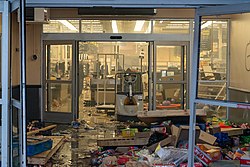 Acute food insecurity estimates for 2020 using the IPC scale | |
| Date | 1 December 2019–present |
|---|---|
| Duration | 5 years, 10 months and 1 week |
| Location | Full list see below |
| Cause | 2019–2021 locust infestation, ongoing armed conflicts, COVID-19 pandemic (including associated recession, lockdowns and travel restrictions) |
During the COVID-19 pandemic, food insecurity intensified in many places. In the second quarter of 2020, there were multiple warnings of famine later in the year. [3] [4] In an early report, the Nongovernmental Organization (NGO) Oxfam-International talks about "economic devastation" [5] while the lead-author of the UNU-WIDER report compared COVID-19 to a "poverty tsunami". [6] Others talk about "complete destitution", [7] "unprecedented crisis", [8] "natural disaster", [9] "threat of catastrophic global famine". [10] The decision of the WHO on 11 March 2020, to qualify COVID as a pandemic, that is "an epidemic occurring worldwide, or over a very wide area, crossing international boundaries and usually affecting a large number of people" also contributed to building this global-scale disaster narrative. [11]
Field evidence collected in more than 60 countries in the course of 2020 [12] indicate, however, that while some disruptions (affecting the stability of the global food system) were reported at local (hoarding) and international (restrictions on exports) levels, those took place primarily during the early days/weeks of the pandemic (and the subsequent waves of lockdowns) and did not lead to any major episode of "global famine", thus invalidating the catastrophic scenario that some experts had initially conjectured.
In September 2020, David Beasley, executive director of the World Food Programme, addressed the United Nations Security Council, stating that measures taken by donor countries over the course of the preceding five months, including the provision of $17 trillion in fiscal stimulus and central bank support, the suspension of debt repayments instituted by the IMF and G20 countries for the benefit of poorer countries, and donor support for WFP programmes, had averted impending famine, helping 270 million people at risk of starvation. [13] As the pandemic-incited food issues began to subside, the 2022 Russian invasion of Ukraine triggered another global food crises compounding already extreme price increases. [14] [15] [16] [17] [18]
| Part of a series on the |
| COVID-19 pandemic |
|---|
 |
|
| |


